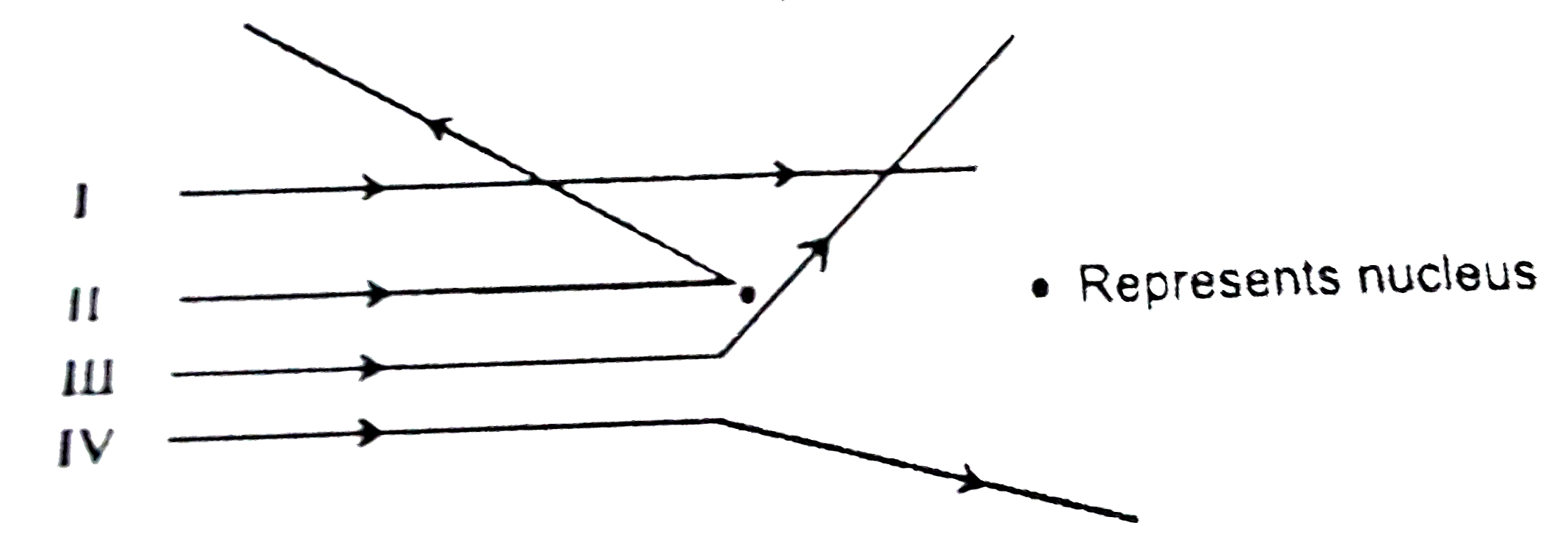Which of the following conclusions could not be derived from Rutherford's α-particle scattering experiment?
Most of the space in the atom is empty.
The radius of the atom is about 10−10m while that of nucleus is 10−15m.
Electrons move in a circular path of fixed energy called orbits.
Electrons and the nucleus are held together by electrostatic forces of attraction.
The correct Answer is:C
To determine which conclusion could not be derived from Rutherford's α-particle scattering experiment, we need to analyze the conclusions that were indeed drawn from the experiment and identify the one that does not align with Rutherford's findings.
1. Understanding Rutherford's Experiment:
- Rutherford conducted an experiment where he bombarded a thin gold foil with α-particles (helium nuclei). Most of the α-particles passed straight through the foil, while a small number were deflected at various angles, and a very few were reflected back.
2. Conclusions from the Experiment:
- Conclusion 1: Most of the atom is empty space. This was concluded because most α-particles passed through without deflection.
- Conclusion 2: The nucleus is very small compared to the size of the atom. This was inferred from the fact that only a few particles were deflected, indicating a small, dense center (the nucleus).
- Conclusion 3: The nucleus contains positively charged protons. This is implied from the deflection of positively charged α-particles by the nucleus.
- Conclusion 4: Electrons are held in orbit around the nucleus by electrostatic forces of attraction. This conclusion was not derived from Rutherford's experiment; it was later proposed by Bohr.
3. Identifying the Incorrect Conclusion:
- Among the options provided, the statement that "electrons move in a circular path of fixed energy called orbits" is not a conclusion that can be drawn from Rutherford's experiment. This concept was introduced by Niels Bohr in his atomic model.
4. Final Answer:
- The conclusion that could not be derived from Rutherford's α-particle scattering experiment is that "electrons move in a circular path of fixed energy called orbits."
- Rutherford conducted an experiment where he bombarded a thin gold foil with α-particles (helium nuclei). Most of the α-particles passed straight through the foil, while a small number were deflected at various angles, and a very few were reflected back.
- Conclusion 1: Most of the atom is empty space. This was concluded because most α-particles passed through without deflection.
- Conclusion 2: The nucleus is very small compared to the size of the atom. This was inferred from the fact that only a few particles were deflected, indicating a small, dense center (the nucleus).
- Conclusion 3: The nucleus contains positively charged protons. This is implied from the deflection of positively charged α-particles by the nucleus.
- Conclusion 4: Electrons are held in orbit around the nucleus by electrostatic forces of attraction. This conclusion was not derived from Rutherford's experiment; it was later proposed by Bohr.
- Among the options provided, the statement that "electrons move in a circular path of fixed energy called orbits" is not a conclusion that can be drawn from Rutherford's experiment. This concept was introduced by Niels Bohr in his atomic model.
- The conclusion that could not be derived from Rutherford's α-particle scattering experiment is that "electrons move in a circular path of fixed energy called orbits."
Topper's Solved these Questions
- BOOK - NCERT FINGERTPS ENGLISHCHAPTER - STRUCTURE OF ATOM EXERCISE - ASSERTION & REASON15videos
STRUCTURE OF ATOM
- BOOK - NCERT FINGERTPS ENGLISHCHAPTER - STRUCTURE OF ATOM EXERCISE - Discovery Of Sub-Atomic Particles5videos
STRUCTURE OF ATOM
- BOOK - NCERT FINGERTPS ENGLISHCHAPTER - STRUCTURE OF ATOM EXERCISE - HIGHER ORDER THINKING SKILLS11videos
STRUCTURE OF ATOM
- BOOK - NCERT FINGERTPS ENGLISHCHAPTER - STATES OF MATTER EXERCISE - Assertion And Reason15videos
STATES OF MATTER
- BOOK - NCERT FINGERTPS ENGLISHCHAPTER - THE P-BLOCK ELEMENTSEXERCISE - Assertion And Reason15videos
THE P-BLOCK ELEMENTS
Similar Questions
Knowledge Check
- Question 1 - Select One
Which of the following observations was not correct during Rutherford's scattering experiment?
AMost of the α-particles passed through the gold foil undeflected.BA small fraction of the α-particles was deflected by small angles.CA large number of the α-particles were bounced back.DA very few α-particles ( ~1 in 20,000) were bounced back. - Question 2 - Select One
Which of the following is not Darwin's conclusion?
ASurvival of the fittestBStruggle for existenceCInheritance of acquired characters aDOrigin of species by natural selection - Question 3 - Select One
Which of the following conclusions regarding the structure of atom is based on Rutherford's α-particle scattering experiment?
AThe positive charge is concentrated in a very small volume of the atom.BThe positive charge is scattered with the electrons throughout the atom.CThe volume occupied by the nucleus is half of the volume of atom.DMost of the space in the atom is occupied by the neutrons.
Rutherford's alpha-scattering experiment
View SolutionWhich of the following conclusions can be drawn from the girdling experiment?
View SolutionWhich of the following chemicals is/are derived from RNA?
View SolutionWhich of the following path of α-particle is/are possible in the α-particle scattering experiment?
 View Solution
View SolutionSource of α-particles used in scattering experiment was
View Solution

